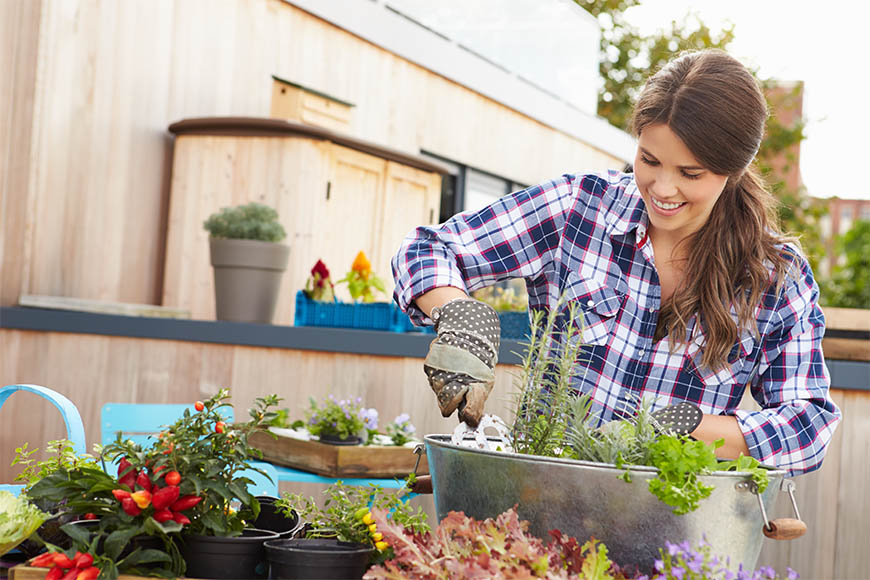
Container gardening is one of the most fun ways to embrace the beauty of plants. With a few pots and a bag of soil, you can grow your own veggies, show off vibrant flowers, and celebrate the unique personalities of a wide array of plants.
Best of all, you can do so without a large yard or devoting a lot of time!
Whether you’re a beginner gardener, a pro, or somewhere in between, curating a container garden comes with a learning curve.
But with some practice and by avoiding these common container gardening mistakes your balcony, patio, porch, or home will glow green and light up with life:
Using Plain Dirt
One of the most common mistakes to make when beginning a container garden is to use soil from your yard or using bagged topsoil from a home improvement store. While these may (or may not) be adequate for a short period of time, they cannot sustain a potted plant for very long.
Why use a high-quality potting soil? Potting soil is designed to provide the appropriate amount of drainage, texture for the roots to easily lengthen, and long-term nutrients. These help your plant:
- Overcome transplant shock
- Build strong cell structures for a longer lifespan
- Resist common diseases and issues.
- Grow larger and more quickly
- Thrive
Furthermore, your plants are an investment, you want to protect your investment. Using a potting soil like Fertilome’s High-Performance Mix or FoxFarm Ocean Forest Potting Mix have optimal: aeration, texture, drainage.
Compacting Your Soil
When transplanting seedlings or adult plants in a typical garden, you will often see the instruction to pat down the soil around the plant. This is not the case for potted plants, though.
When transplanting your new plants into containers, you will want to put a base layer of your potting mix down, and rest your new plant at the center of this layer.
Then fill in around the plant with your soil. You will know you have enough soil when the plant can stand upright unassisted.
Next, add a thin layer of soil to the top and water. Do not pack down your soil at any point. This eliminates pockets and space for the roots to grow and fill in. It can also make it more difficult for your plant to take up water and respirate.
Skipping the Mulch
When your container garden is outdoors, you must take extra precautions to prevent the weather from damaging your plants. Mulch is one of these safeguards!
If you live in a hot, humid, or dry area, a layer of mulch will help keep your soil moist. Mulch retains water, slowly releasing it as the soil beneath dries out.
This can come in handy if you forget to water your plants!
Not Feeding Your Plants
Imagine you’re making a lemon meringue pie. So, you go to the store to pick up your main ingredient, and they’re out of lemons. What do you do? You likely go to another store, right?
Well, if this analogy were a potted plant, you’d be stuck with only the first store. Why? Plants use the nutrients in their immediate soil and then they send out their roots further and wider for more once the immediate area is depleted.
But when a plant is stuck in a pot, its roots cannot source nutrients elsewhere. This is where plant food comes in.
Feeding your plant replenishes its soil with nutrients. Indoor plants and outdoor container gardens need to be fed regularly in spring, summer, and fall. Indoor gardens relying on grow lights need food in winter, as well.
Ferti-lome is an excellent all-around fertilizer for indoor or outside container gardens.
For flowering plants, you will want to provide them with a feed that will support them leading up to blooms and beyond. Flower Girl Organic is a great choice for bloomers.
Pro tip: Fish naturally produce potassium, phosphorus, nitrogen, and other trace nutrients along with beneficial bacteria. And plants LOVE this stuff!
If you have a fish tank, you can use the water you cycle out to water container plants as a natural and highly effective fertilizer.
If you don’t have a fish, have no fear, Fish Sh!t will give all of your container plants a dose of goodness--this stuff is great.
Mishandling Roots During Transplant
There’s nothing more disheartening than getting a new, glowing plant home, repotting it, and then watching it slowly wilt away. This is often because the roots were prepped properly for its new home.
One frequent mistake gardeners make when repotting is not loosening roots or untangling the roots.
One easy way to make loosening roots easier is to bottom soak your plant for about an hour before repotting. If a plant is extremely root-bound, you can snip the roots to free them, but avoid cutting away thick roots.
Pro-tip: Winter is the best time to repot--not just because there are fewer gardening chores to keep you busy, but because your outdoor plants will not be in their growing phase.
We bet you can hardly contain your excitement for diving into the dirt and selecting the most fun pots for your container garden!
Remember to have fun and always read the care instructions for individual plants. Over time, you’ll get into the rhythm of knowing which container mistakes to avoid.
Keep up the Green Work!
